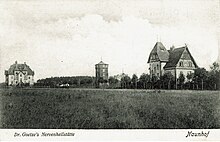Rudolf Gotze
Rudolf Emil Fritz Götze , also Rudolf Goetze (born September 23, 1863 in Glauchau , † October 30, 1920 in Alzey ), was a German neurologist .
Live and act
Rudolf Götze was born as the son of the weaving mill owner and businessman Emil Goetze. From 1884 to 1889 he studied medicine at the University of Leipzig . After studying philosophical works and music, and especially Richard Wagner , he published his first book “Heinrich v. Stein, Schopenhauer and Richard Wagner ”. In the summer of 1890 he was licensed as a doctor in Berlin and, after passing his exam, served as a junior doctor in the Royal Saxon until April 1991. Leibgrenadier Regment in Dresden. He then devoted himself to 1893 as an assistant doctor at the Würzburg Psychiatric Clinic under Professor Rieger, in particular studying nervous and mental diseases.
He married Elsa Römmler (born April 7, 1868) in Dresden in 1892 . The marriage resulted in 7 children, including Albrecht Götze . In 1892 he received his doctorate in Berlin with the dissertation “Die Bleivergiftung”, which is still available today as a classic of medical literature.
In 1893 he became an assistant doctor under Robert Sommer at the Clinic for Physical and Nervous Diseases in Giessen .
From 1893 to 1896, together with Joseph Kürschner, he managed the purchase of the Richard Wagner collection from Nikolaus Oesterlein in Vienna and its transfer to the Reuter Wagner Museum in Eisenach .
From 1894 he was the medical director of the polyclinic for the mentally ill of the Albertzweigverein in Leipzig .
In 1896 he published his work "Pathology and Irrenrecht".
In 1896 Götze received permission to build a country house on Großsteinbergerstrasse near the state forest as a sanatorium for the mentally ill in Naunhof , which he wanted to set up and manage according to the principles of Paul Julius Möbius and moved to Naunhof in 1897. From July 1900, Götze had another country-style building built on his property by the Leipzig architect Anton Käppler . After completion, he will move his mental health center to this building. In 1903, he built two log huts on the edge of the forest of the sanatorium for the treatment of his patients. The waterworks that supplied the sanatorium with drinking water was also located in the immediate vicinity of the two buildings. After the waterworks went bankrupt in 1903, Götze continued to operate it until 1905.
On March 13, 1906, the Naunhofer Nachrichten reported about a suicide of a patient Götzes by hanging.
In April 1907 Götze announced the closure of the mental health facility. In 1907 Götze published “On Nervous Illnesses and Mental Health Centers”, moved to Heppenheim and worked at the local sanatorium as a senior physician and medical advisor. Presumably at the same time he moved his residence to Darmstadt, about 30 km away from there .
In 1909 his mental health center in Naunhof was sold for 70,000 RM to the AOK Leipzig , which opened a rest home in the building and on the property in 1909.
Shortly before his death, he switched to the hospital in Alzey as a doctor.
Web links
- Literature by and about Rudolf Götze in the catalog of the German National Library
- Literature by and about Rudolf Götze in the bibliographic database WorldCat
swell
- Who is it ? 5th edition, Herrmann Degener , Leipzig, 1911, p. 473
- Julius Pagel : Biographical lexicon of outstanding doctors of the nineteenth century. Berlin, Vienna 1901, Col. 608
- Naunhofer Nachrichten 1896 No. 58, 1899 No. 48 and 54, 1900 No. 86, 1903 No. 32 and 98, 1905 No. 31 and 32, 1906 No. 31 and 91, 1907 No. 48
- Biographical contribution by Utz Maas in the database tracking and emigration of German-speaking linguists 1933-1945 (accessed: April 13, 2018)
- Annual report of AOK Leipzig 1909, pages 57 and 58
- Statements of the local writers Naunhof
| personal data | |
|---|---|
| SURNAME | Gotze, Rudolf |
| ALTERNATIVE NAMES | Götze, Rudolf Emil Fritz (full name); Goetze, Rudolf |
| BRIEF DESCRIPTION | German neurologist |
| DATE OF BIRTH | September 23, 1863 |
| PLACE OF BIRTH | Glauchau |
| DATE OF DEATH | October 30, 1920 |
| Place of death | Alzey |
